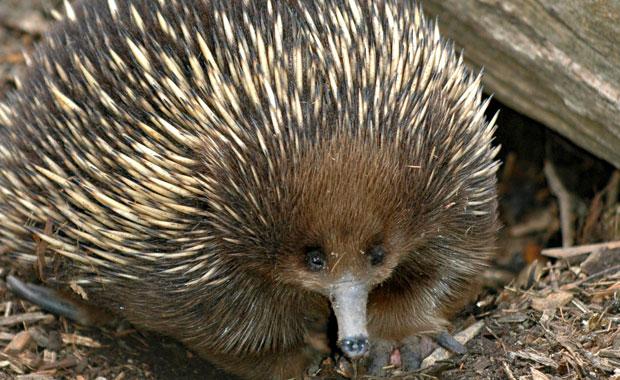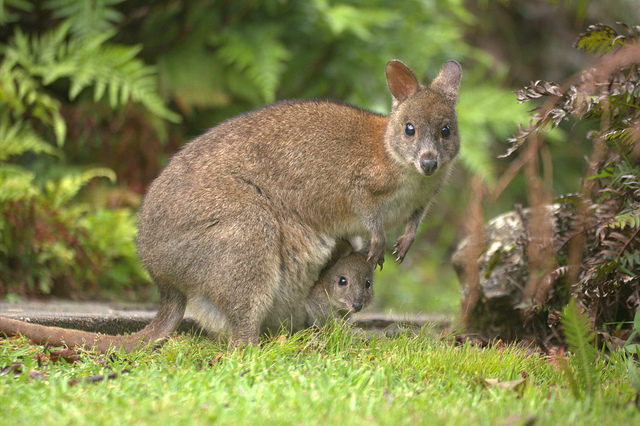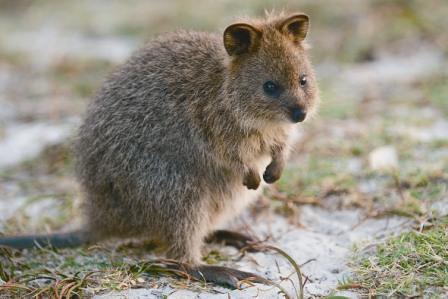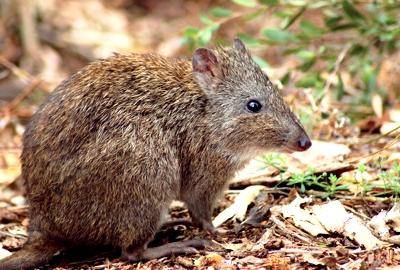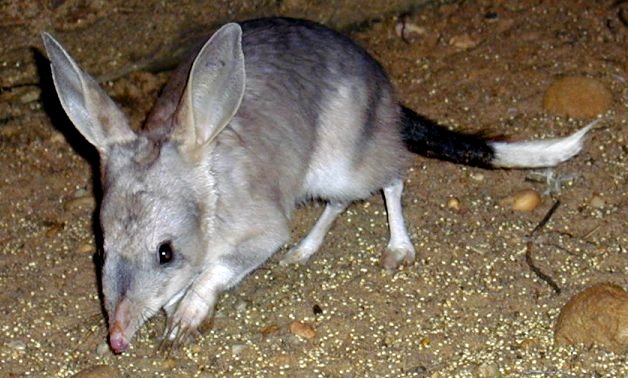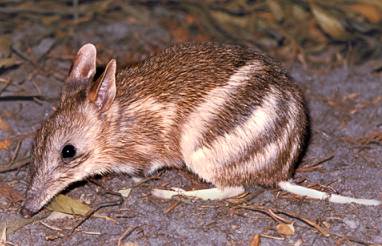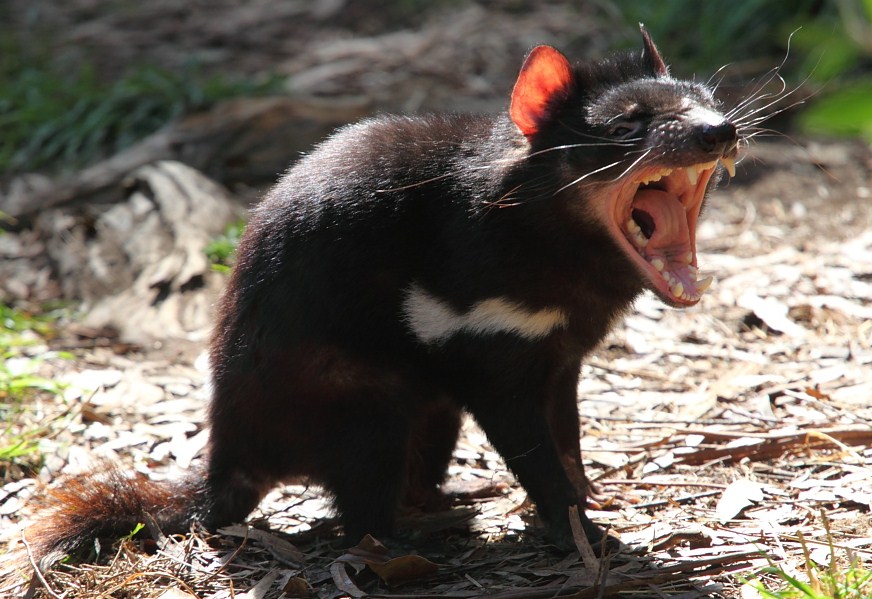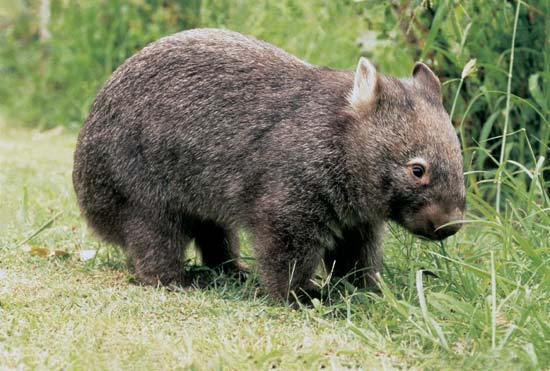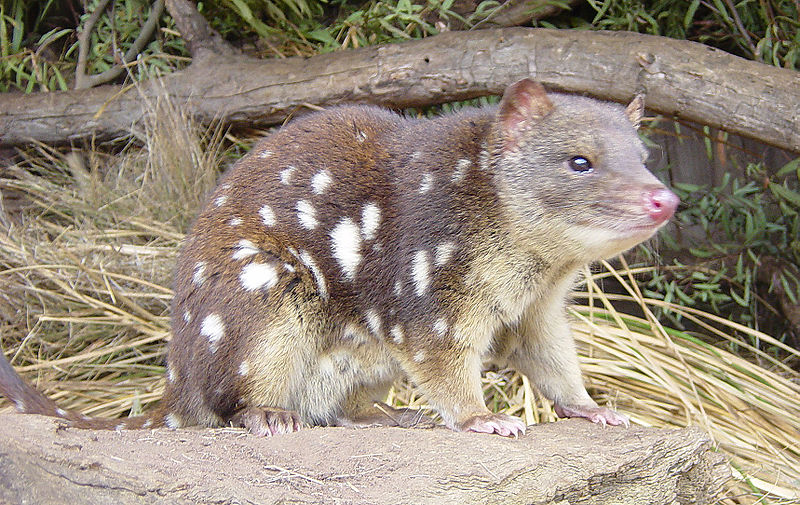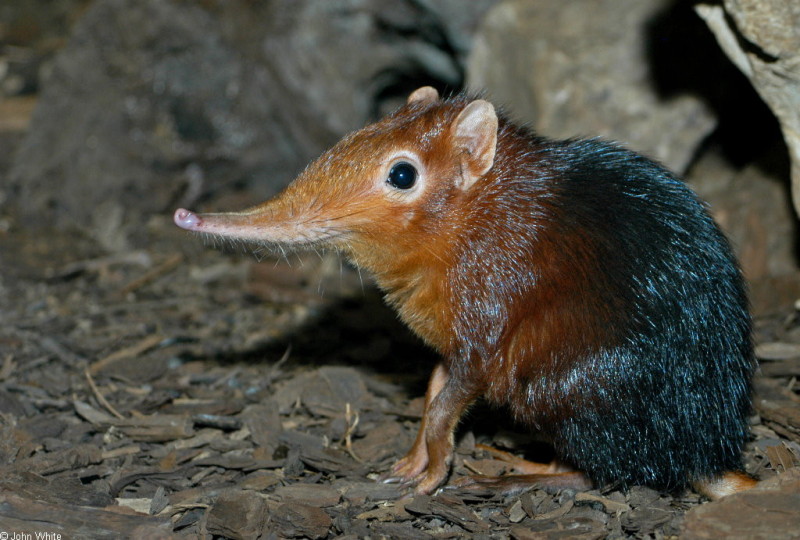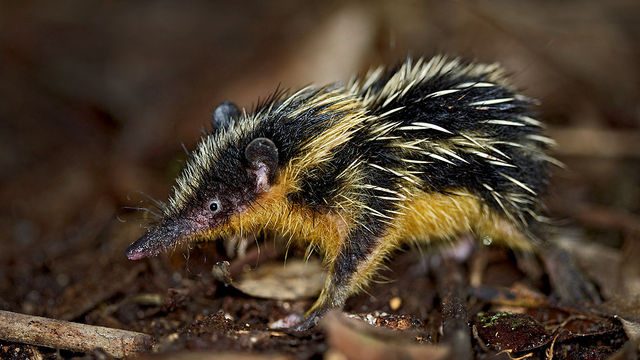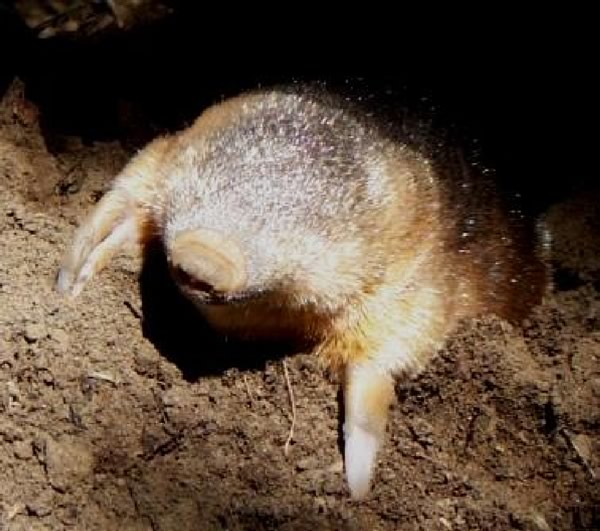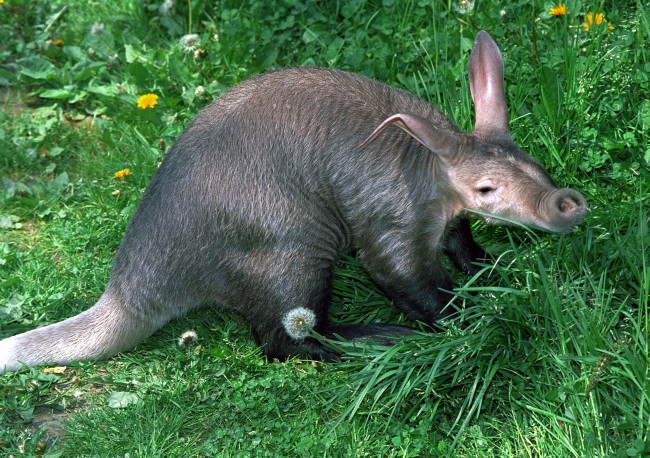Difference between revisions of "Physical World/Mammals - 1"
(Added images) |
(Formatting edits) |
||
| Line 5: | Line 5: | ||
''Ornithorhynchus anatinus'' | ''Ornithorhynchus anatinus'' | ||
| + | |||
Egg-laying mammal endemic to eastern Australia, including Tasmania | Egg-laying mammal endemic to eastern Australia, including Tasmania | ||
| − | |||
The male platypus has a spur on the hind foot that delivers venom capable of causing severe pain to humans | The male platypus has a spur on the hind foot that delivers venom capable of causing severe pain to humans | ||
| Line 19: | Line 19: | ||
The four extant species, together with the platypus, are the only surviving members of the Monotremata order and are the only extant mammals that lay eggs | The four extant species, together with the platypus, are the only surviving members of the Monotremata order and are the only extant mammals that lay eggs | ||
| − | |||
Also known as spiny anteaters. Baby echidna is called a puggle | Also known as spiny anteaters. Baby echidna is called a puggle | ||
| Line 30: | Line 29: | ||
Besides their smaller size, pademelons can be distinguished from wallabies by their shorter, thicker, and sparsely haired tails | Besides their smaller size, pademelons can be distinguished from wallabies by their shorter, thicker, and sparsely haired tails | ||
| − | |||
Usually found in forests | Usually found in forests | ||
| Line 50: | Line 48: | ||
A kangaroo-like marsupial about the size of a rabbit | A kangaroo-like marsupial about the size of a rabbit | ||
| − | |||
Gilbert's potoroo is Australia's most endangered animal | Gilbert's potoroo is Australia's most endangered animal | ||
| Line 59: | Line 56: | ||
''Didelphis virginiana'' | ''Didelphis virginiana'' | ||
| + | |||
The only marsupial found in North America north of Mexico. In the United States, it is typically referred to simply as a possum. It is a solitary and nocturnal animal about the size of a domestic cat. | The only marsupial found in North America north of Mexico. In the United States, it is typically referred to simply as a possum. It is a solitary and nocturnal animal about the size of a domestic cat. | ||
| Line 70: | Line 68: | ||
Also known as rabbit-bandicoot | Also known as rabbit-bandicoot | ||
| − | |||
An Australian desert-dwelling marsupial omnivore. Bilbies have a long muzzle and very long ears | An Australian desert-dwelling marsupial omnivore. Bilbies have a long muzzle and very long ears | ||
| Line 88: | Line 85: | ||
''Sarcophilus harrisii'' | ''Sarcophilus harrisii'' | ||
| + | |||
The size of a small dog, it became the largest carnivorous marsupial in the world following the extinction of the thylacine in 1936 | The size of a small dog, it became the largest carnivorous marsupial in the world following the extinction of the thylacine in 1936 | ||
| − | |||
Now found in the wild only on Tasmania | Now found in the wild only on Tasmania | ||
| Line 102: | Line 99: | ||
There are three species of wombat – Common, Northern Hairy-nosed and Southern Hairy-nosed | There are three species of wombat – Common, Northern Hairy-nosed and Southern Hairy-nosed | ||
| − | |||
Fatso the Fat-Arsed Wombat was an unofficial mascot of the Sydney 2000 Summer Olympics | Fatso the Fat-Arsed Wombat was an unofficial mascot of the Sydney 2000 Summer Olympics | ||
| Line 111: | Line 107: | ||
''Phascolarctos cinereus'' | ''Phascolarctos cinereus'' | ||
| + | |||
An arboreal herbivorous marsupial. Its closest living relatives are the wombats. Because their eucalypt diet has limited nutritional and caloric content, koalas are largely sedentary and sleep for up to 20 hours a day. Koala is one of the few mammals (other than primates) that have fingerprints. Name means “no drink" | An arboreal herbivorous marsupial. Its closest living relatives are the wombats. Because their eucalypt diet has limited nutritional and caloric content, koalas are largely sedentary and sleep for up to 20 hours a day. Koala is one of the few mammals (other than primates) that have fingerprints. Name means “no drink" | ||
|- | |- | ||
| − | | | + | |[[File:Quoll.jpg|none|thumb]] |
|'''Quoll''' | |'''Quoll''' | ||
genus ''Dasyurus'' | genus ''Dasyurus'' | ||
| + | |||
A carnivorous marsupial native to Australia and New Guinea. It has a brown coat with white spots. It is primarily nocturnal | A carnivorous marsupial native to Australia and New Guinea. It has a brown coat with white spots. It is primarily nocturnal | ||
|- | |- | ||
| − | | | + | |[[File:Elephant shrew.jpg|none|thumb]] |
|'''Elephant shrew''' | |'''Elephant shrew''' | ||
| Line 133: | Line 131: | ||
Also known as sengis | Also known as sengis | ||
|- | |- | ||
| − | | | + | |[[File:Tenrec.jpg|none|thumb]] |
|'''Tenrec''' | |'''Tenrec''' | ||
| Line 144: | Line 142: | ||
Found on Madagascar and in parts of the African mainland | Found on Madagascar and in parts of the African mainland | ||
|- | |- | ||
| − | | | + | |[[File:Golden mole.jpg|none|thumb]] |
|'''Golden mole''' | |'''Golden mole''' | ||
| Line 153: | Line 151: | ||
Insectivorous burrowing mammals native to southern Africa. The golden moles bear a resemblance to the marsupial moles of Australia | Insectivorous burrowing mammals native to southern Africa. The golden moles bear a resemblance to the marsupial moles of Australia | ||
|- | |- | ||
| − | | | + | |[[File:Aardvark.jpg|none|thumb]] |
|'''Aardvark''' | |'''Aardvark''' | ||
''Orycteropus afer'' | ''Orycteropus afer'' | ||
| + | |||
Feeds almost exclusively on ants and termites. The name comes from earlier Afrikaans and means ‘earth pig’. Aardvark is sometimes colloquially called antbear, anteater, or the Cape anteater | Feeds almost exclusively on ants and termites. The name comes from earlier Afrikaans and means ‘earth pig’. Aardvark is sometimes colloquially called antbear, anteater, or the Cape anteater | ||
| Line 166: | Line 165: | ||
order Hyracoidea | order Hyracoidea | ||
| + | |||
They are often mistaken for rodents, but are more closely related to elephants and manatees. Four species are recognised; the rock hyrax (pictured), the yellow-spotted rock hyrax, the western tree hyrax and the southern tree hyrax | They are often mistaken for rodents, but are more closely related to elephants and manatees. Four species are recognised; the rock hyrax (pictured), the yellow-spotted rock hyrax, the western tree hyrax and the southern tree hyrax | ||
| Line 177: | Line 177: | ||
Also known as the Borneo pygmy elephant | Also known as the Borneo pygmy elephant | ||
| − | |||
The Sultan of Sulu introduced captive elephants to Borneo in the 18th century, which were released into the jungle | The Sultan of Sulu introduced captive elephants to Borneo in the 18th century, which were released into the jungle | ||
| Line 195: | Line 194: | ||
''Myrmecophaga tridactyla'' | ''Myrmecophaga tridactyla'' | ||
| + | |||
Also known as the ant bear | Also known as the ant bear | ||
| − | |||
Native to Central and South America. All anteaters have elongated snouts equipped with a thin tongue that can be extended to a length greater than the length of the head; their tube-shaped mouths have lips but no teeth | Native to Central and South America. All anteaters have elongated snouts equipped with a thin tongue that can be extended to a length greater than the length of the head; their tube-shaped mouths have lips but no teeth | ||
| Line 209: | Line 208: | ||
Within the order of lagomorphs, which also includes the Leporidae (rabbits and hares) | Within the order of lagomorphs, which also includes the Leporidae (rabbits and hares) | ||
| − | |||
It is also known as the "whistling hare" due to its high-pitched alarm call when diving into its burrow | It is also known as the "whistling hare" due to its high-pitched alarm call when diving into its burrow | ||
| Line 221: | Line 219: | ||
Also known as a woodchuck, whistle-pig, or land-beaver in some areas It is a rodent of the family Sciuridae, belonging to the group of large ground squirrels known as marmots | Also known as a woodchuck, whistle-pig, or land-beaver in some areas It is a rodent of the family Sciuridae, belonging to the group of large ground squirrels known as marmots | ||
| − | |||
Groundhog Day is celebrated on February 2 | Groundhog Day is celebrated on February 2 | ||
| Line 232: | Line 229: | ||
They are a type of ground squirrel. Burrowing rodents native to the grasslands of North America | They are a type of ground squirrel. Burrowing rodents native to the grasslands of North America | ||
| − | |||
Prairie dogs are named for their habitat and warning call, which sounds similar to a dog's bark | Prairie dogs are named for their habitat and warning call, which sounds similar to a dog's bark | ||
| Line 244: | Line 240: | ||
Also known as pocket gophers | Also known as pocket gophers | ||
| − | |||
Gophers live in Central and North America. They are commonly known for their extensive tunneling activities | Gophers live in Central and North America. They are commonly known for their extensive tunneling activities | ||
| Line 253: | Line 248: | ||
genus ''Dipodomys'' | genus ''Dipodomys'' | ||
| + | |||
The common name derives from their bipedal form. They hop in a manner similar to the much larger kangaroo, although they are not related. Native to North America | The common name derives from their bipedal form. They hop in a manner similar to the much larger kangaroo, although they are not related. Native to North America | ||
| Line 264: | Line 260: | ||
Also known as the dwarf three-toed jerboa | Also known as the dwarf three-toed jerboa | ||
| − | |||
Smallest rodent in the world. Adults average only 4.4 cm (1.7 in) in head and body length | Smallest rodent in the world. Adults average only 4.4 cm (1.7 in) in head and body length | ||
| Line 284: | Line 279: | ||
genus ''Dolichotis'' | genus ''Dolichotis'' | ||
| + | |||
A genus of the cavy family. These large relatives of guinea pigs are common in the Patagonian steppes of Argentina | A genus of the cavy family. These large relatives of guinea pigs are common in the Patagonian steppes of Argentina | ||
| Line 291: | Line 287: | ||
| − | ''Hydrochoerus hydrochaeris'' | + | ''Hydrochoerus hydrochaeris'' |
The largest living rodent in the world (ahead of the beaver and porcupine). Found wild in much of South America | The largest living rodent in the world (ahead of the beaver and porcupine). Found wild in much of South America | ||
| − | |||
Very popular with quiz setters. The Billy Fury of Rodentia | Very popular with quiz setters. The Billy Fury of Rodentia | ||
| Line 312: | Line 307: | ||
''Octodon degus'' | ''Octodon degus'' | ||
| + | |||
Small rodent endemic to Chile. It is sometimes referred to as the brush-tailed rat | Small rodent endemic to Chile. It is sometimes referred to as the brush-tailed rat | ||
| − | |||
Degus have an intolerance to dietary sugar and are used in diabetes research | Degus have an intolerance to dietary sugar and are used in diabetes research | ||
| Line 323: | Line 318: | ||
genus ''Dasyprocta'' | genus ''Dasyprocta'' | ||
| + | |||
Native to the Americas. They are related to guinea pigs and look quite similar, but are larger and have longer legs | Native to the Americas. They are related to guinea pigs and look quite similar, but are larger and have longer legs | ||
| Line 340: | Line 336: | ||
genus ''Nycticebus'' | genus ''Nycticebus'' | ||
| + | |||
Only venomous primate. The toxin is produced by licking a gland on their arm, and the secretion mixes with its saliva to activate it | Only venomous primate. The toxin is produced by licking a gland on their arm, and the secretion mixes with its saliva to activate it | ||
| − | |||
The group's closest relatives are the arboreal slender lorises | The group's closest relatives are the arboreal slender lorises | ||
Revision as of 17:48, 3 July 2021
| Duck-billed platypus
The male platypus has a spur on the hind foot that delivers venom capable of causing severe pain to humans | |
| Echidna
Also known as spiny anteaters. Baby echidna is called a puggle | |
| Pademelon
Besides their smaller size, pademelons can be distinguished from wallabies by their shorter, thicker, and sparsely haired tails Usually found in forests | |
| Quokka
The quokka is herbivorous and mainly nocturnal. Quokkas can be found on some smaller islands off the coast of Western Australia, in particular on Rottnest Island just off Perth. It is about the size of a domestic cat | |
| Potoroo
Gilbert's potoroo is Australia's most endangered animal | |
| Virginia opossum
| |
| Bilby
An Australian desert-dwelling marsupial omnivore. Bilbies have a long muzzle and very long ears | |
| Bandicoot
| |
| Tasmanian devil
Now found in the wild only on Tasmania | |
| Wombat
Fatso the Fat-Arsed Wombat was an unofficial mascot of the Sydney 2000 Summer Olympics | |
| Koala
| |
| Quoll
| |
| Elephant shrew
Also known as sengis | |
| Tenrec
Found on Madagascar and in parts of the African mainland | |
| Golden mole
| |
| Aardvark
| |
| Hyrax
| |
| Borneo elephant
The Sultan of Sulu introduced captive elephants to Borneo in the 18th century, which were released into the jungle | |
| Armadillo
| |
| Giant anteater
Native to Central and South America. All anteaters have elongated snouts equipped with a thin tongue that can be extended to a length greater than the length of the head; their tube-shaped mouths have lips but no teeth | |
| Pika
It is also known as the "whistling hare" due to its high-pitched alarm call when diving into its burrow | |
| Groundhog
Groundhog Day is celebrated on February 2 | |
| Prairie dog
They are a type of ground squirrel. Burrowing rodents native to the grasslands of North America Prairie dogs are named for their habitat and warning call, which sounds similar to a dog's bark | |
| Gopher
Gophers live in Central and North America. They are commonly known for their extensive tunneling activities | |
| Kangaroo rat
| |
| Baluchistan pygmy jerboa
Smallest rodent in the world. Adults average only 4.4 cm (1.7 in) in head and body length | |
| Norway lemming
Lemmings do not commit mass suicide when they migrate | |
| Mara
| |
| Capybara
The largest living rodent in the world (ahead of the beaver and porcupine). Found wild in much of South America Very popular with quiz setters. The Billy Fury of Rodentia | |
| Paca
| |
| Degu
Degus have an intolerance to dietary sugar and are used in diabetes research | |
| Common agouti
| |
| Colugo
| |
| Slow loris
The group's closest relatives are the arboreal slender lorises | |
| Galago
| |
| Potto
In the same family as the lorises
| |
| Ring-tailed lemur
The most recognized lemur due to its long, black and white ringed tail. Like all lemurs it is endemic to the island of Madagascar and female dominant | |
| Aye-aye
A lemur native to Madagascar and the world’s largest nocturnal primate Aye-ayes tap on the trunks and branches of the trees, and listen to the echo produced to find hollow chambers inside. Once a chamber is found, they chew a hole into the wood and get grubs out of that hole with their narrow and bony middle finger | |
| Tarsier
|

